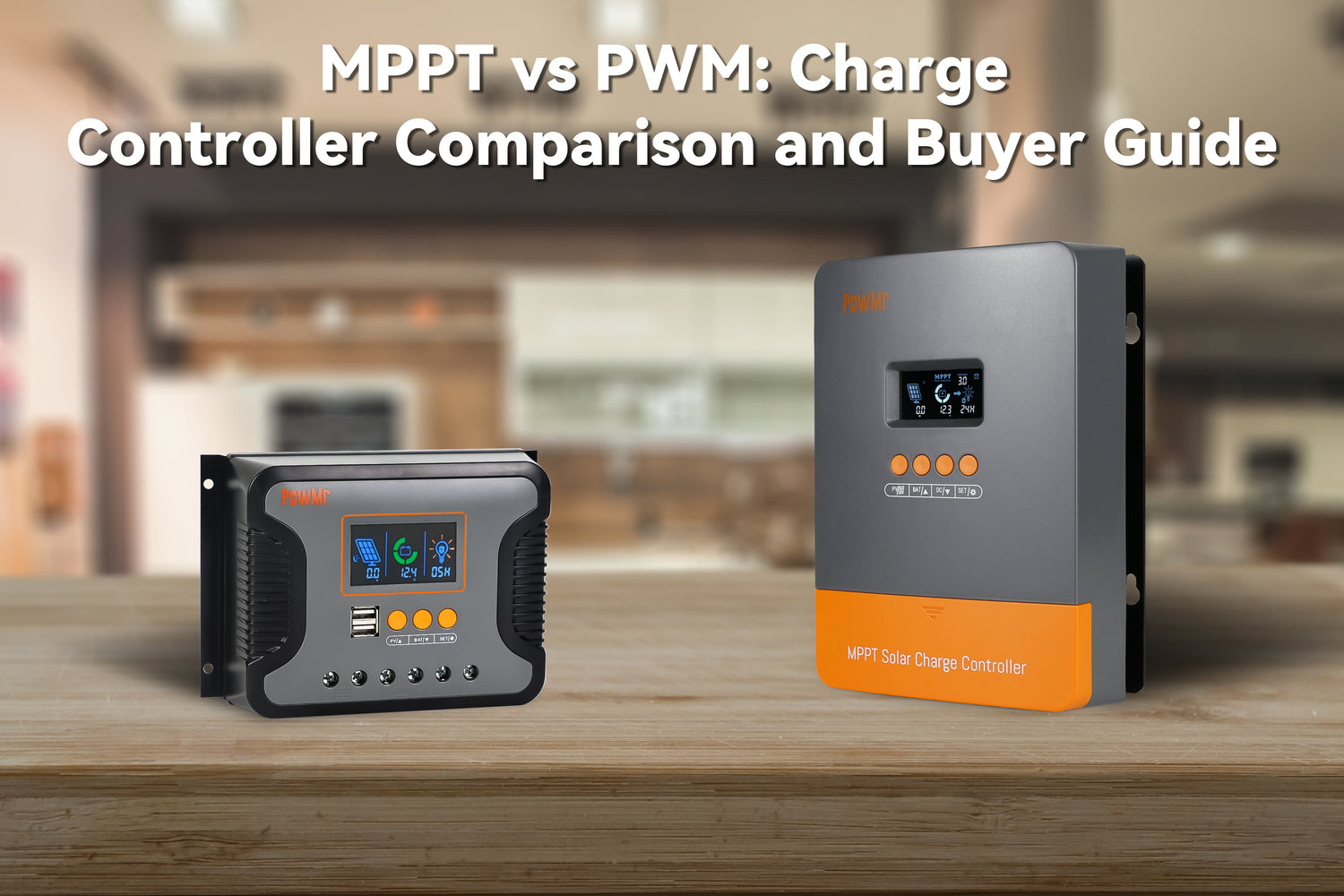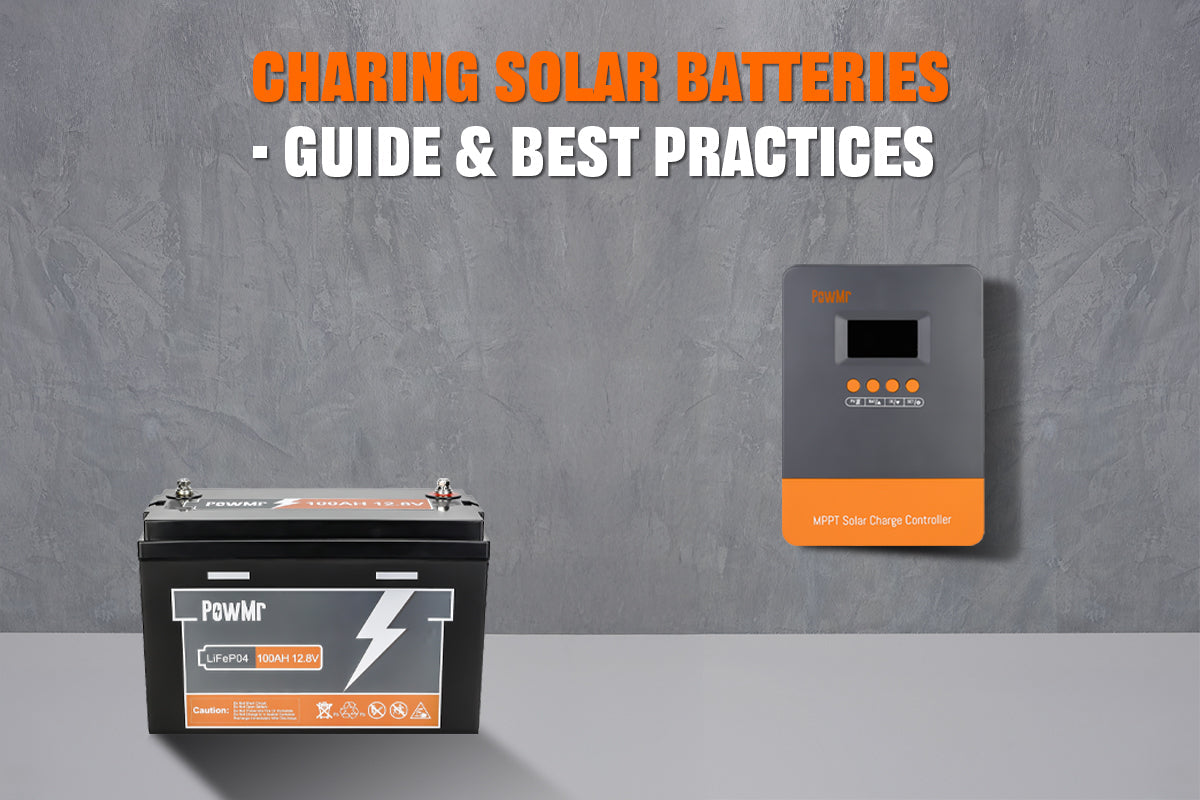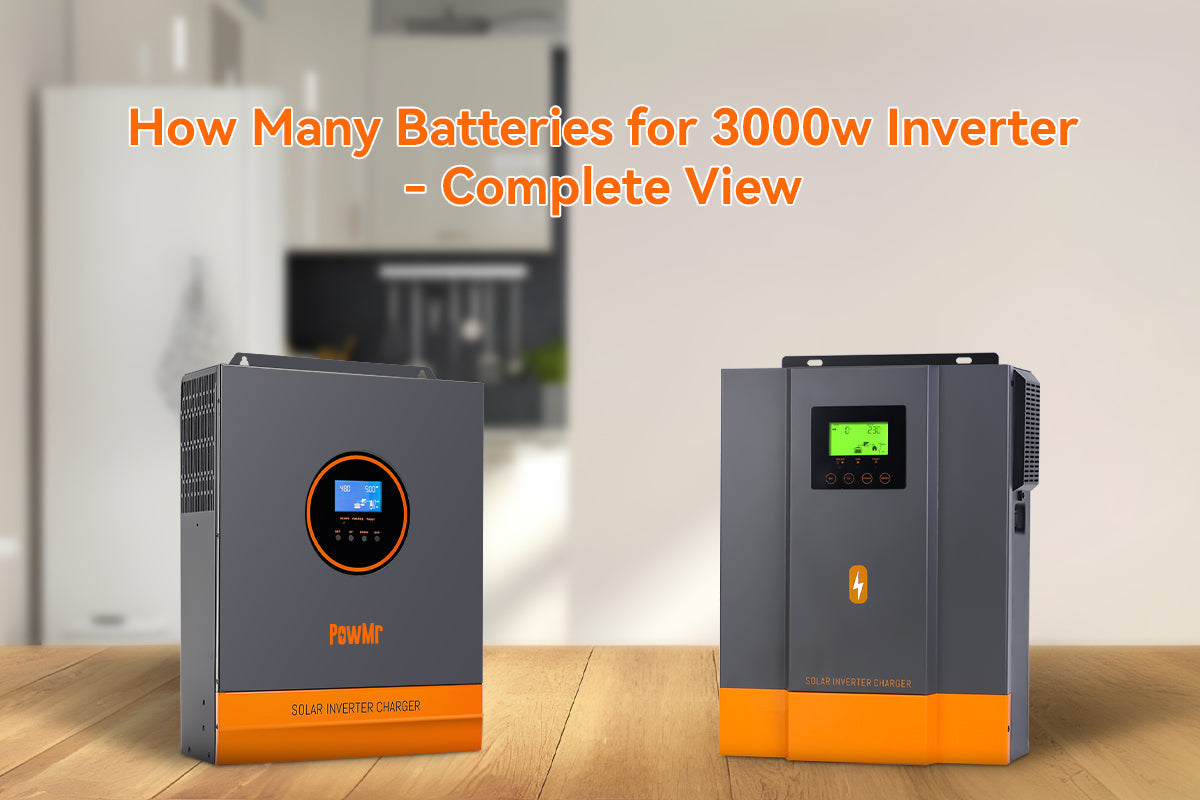เมื่อกำหนดระบบพลังงานแสงอาทิตย์ การตัดสินใจที่สำคัญอย่างหนึ่งคือการเลือกประเภทของตัวควบคุมการชาร์จพลังงานแสงอาทิตย์ที่เหมาะสม ตัวควบคุมการชาร์จพลังงานแสงอาทิตย์ สองประเภทหลัก ที่ครองตลาดคือ ตัวควบคุมการชาร์จพลังงานแสงอาทิตย์แบบ MPPT และ ตัวควบคุมการชาร์จพลังงานแสงอาทิตย์แบบ PWM ทั้งสองประเภทควบคุมการไหลของกระแสไฟฟ้าจากแผงโซลาร์เซลล์ไปยังแบตเตอรี่ของคุณ แต่ทำในวิธีที่แตกต่างกันอย่างมาก
ในบทความนี้ เราจะวิเคราะห์ ความแตกต่างที่สำคัญ ระหว่าง MPPT และ PWM charge controllers สำรวจ ข้อดีและข้อเสีย ของแต่ละประเภท และช่วยคุณตัดสินใจว่าแบบไหนดีกว่าสำหรับการติดตั้งพลังงานแสงอาทิตย์ของคุณ
MPPT charge controller คืออะไร
MPPT ซึ่งย่อมาจาก Maximum Power Point Tracking เป็นเทคนิคที่ใช้เพื่อเพิ่มผลผลิตพลังงานจากแผงโซลาร์เซลล์ MPPT solar charge controllerติดตามและปรับ จุดการทำงานของระบบอย่างต่อเนื่องตามสมการ P = V × A (พลังงาน = แรงดัน × กระแส) เพื่อให้แน่ใจว่าแผงจะส่งมอบ พลังงานสูงสุดที่เป็นไปได้ ภายใต้สภาพอากาศที่เปลี่ยนแปลง ดังนั้น MPPT solar charge controllers จึงแสดงประสิทธิภาพที่แตกต่างกันขึ้นอยู่กับสภาพอากาศ.

ข้อดีของตัวควบคุมการชาร์จพลังงานแสงอาทิตย์ MPPT
ประสิทธิภาพการชาร์จที่สูงขึ้น
โดยทั่วไปแล้ว ตัวควบคุม MPPT จะทำงานที่ประสิทธิภาพสูงสุดถึง 99% โดยการปรับแต่งการผลิตพลังงานอย่างต่อเนื่องเพื่อดึงพลังงานมากที่สุด โดยเฉพาะในสภาพอากาศที่มีเมฆหรือเมื่อแผงเซลล์แสงอาทิตย์ไม่ได้รับแสงแดดเต็มที่ นอกจากนี้ ยังมี การชดเชยอุณหภูมิ ซึ่งช่วยปรับปรุงประสิทธิภาพในสภาพอากาศหนาว.
การผลิตพลังงานแสงอาทิตย์สูงสุด
MPPT คอนโทรลเลอร์ใช้อัลกอริธึมขั้นสูงเพื่อติดตามการป้อนพลังงานจากแสงอาทิตย์อย่างแม่นยำและ แปลงแรงดันไฟฟ้าที่เกินออกมาเป็นพลังงานที่สามารถใช้งานได้ ซึ่งเก็บไว้ในแบตเตอรี่ เพิ่มผลผลิตพลังงานได้สูงสุดถึง 30% ในสภาวะที่เหมาะสม.
การจับคู่ที่สมบูรณ์แบบสำหรับระบบขนาดใหญ่
MPPT คอนโทรลเลอร์เหมาะที่สุดสำหรับระบบพลังงานแสงอาทิตย์ขนาดใหญ่ที่มีความต้องการพลังงานสูงและการจ่ายแรงดันไฟฟ้าสูง ทำให้เหมาะสำหรับการสำรองพลังงานที่บ้าน, กระท่อมที่ไม่เชื่อมต่อกับกริด, หรือการติดตั้งแบบไฮบริดที่ใช้แบตเตอรี่ลิเธียม.
ข้อเสียของตัวควบคุมการชาร์จพลังงานแสงอาทิตย์ MPPT
ต้องการการลงทุนล่วงหน้าที่สูงขึ้น
ตัวควบคุม MPPT มักมีราคาแพงกว่ารุ่น PWM ค่าใช้จ่ายเริ่มต้นที่สูงกว่านี้อาจไม่เหมาะสมสำหรับผู้ใช้ที่สร้างระบบขนาดเล็กหรือมีงบประมาณจำกัดที่ไม่ได้รับประโยชน์จากการปรับปรุงประสิทธิภาพมากนัก.
PWM charge controller คืออะไร
ตัวควบคุมการชาร์จพลังงานแสงอาทิตย์ PWM (Pulse Width Modulation) ทำหน้าที่เป็นสวิตช์อัจฉริยะระหว่างแผงโซลาร์เซลล์และแบตเตอรี่ โดยการควบคุมการชาร์จโดยการเปิด/ปิดการป้อนพลังงานแสงอาทิตย์อย่างรวดเร็ว โดยการปรับรอบการทำงาน พวกเขาจะรักษากระแสเฉลี่ยที่ควบคุมได้ในขณะที่ยังคงแรงดันไฟฟ้าของแผงโซลาร์เซลล์ให้ตรงกับแรงดันไฟฟ้าสำหรับการชาร์จของแบตเตอรี่ เมื่อใกล้เต็ม พลังงานที่ส่งมอบจะลดลง

ข้อดีของตัวควบคุมการชาร์จพลังงานแสงอาทิตย์แบบ PWM
ต้นทุนต่ำกว่า
PWM charge controllers มีราคาที่ไม่แพงและหาซื้อได้ทั่วไป พวกเขาเป็นตัวเลือกที่ดีสำหรับผู้ที่ทำเองหรือผู้ใช้ที่มีงบประมาณจำกัดที่ต้องการโซลูชันการชาร์จพลังงานแสงอาทิตย์ที่พื้นฐานและใช้งานได้โดยไม่ต้องการประสิทธิภาพที่สูงมาก
ความเสี่ยงต่ำและการบำรุงรักษาง่าย
โครงสร้างภายในของ PWM solar charge controller ค่อนข้างเรียบง่าย โดยมี ส่วนประกอบน้อยกว่า ที่เกี่ยวข้อง ซึ่งไม่เพียงแต่ลดความเสี่ยงของการล้มเหลวของระบบ แต่ยังทำให้การแก้ไขปัญหา การซ่อมแซม และการบำรุงรักษาในระยะยาวทำได้ง่ายขึ้นอีกด้วย.
ข้อเสียของ PWM solar charge controller
อัตราการใช้พลังงานแสงอาทิตย์ที่ต่ำกว่า
ตัวควบคุมการชาร์จพลังงานแสงอาทิตย์แบบ PWM จะรักษาแรงดันไฟฟ้าที่คงที่ซึ่งเท่ากับสถานะปัจจุบันของแบตเตอรี่ในขณะที่ปรับกระแสไฟฟ้า แตกต่างจาก MPPT มันไม่แปลงแรงดันไฟฟ้าที่เกินออกมาเป็นกระแสไฟฟ้าที่ใช้งานได้—แทนที่จะทำเช่นนั้น มัน ระบายแรงดันไฟฟ้าที่เกินออกมาเป็นความร้อน โดยการตัดสัญญาณขาเข้าแทนที่จะใช้มัน.
จำกัดเฉพาะระบบขนาดเล็กหรือระดับเริ่มต้น
สำหรับระบบที่ไม่เชื่อมต่อกับกริดขนาดใหญ่หรือระบบสำรอง ตัวควบคุม PWM ไม่มีความสามารถในการจ่ายไฟหรือประสิทธิภาพที่จำเป็น การพยายามขยายระบบ PWM จะส่งผลให้ประสิทธิภาพต่ำและสูญเสียพลังงาน
ความแตกต่างระหว่าง MPPT และ PWM
ความแตกต่างพื้นฐานในวิธีการทำงานของ MPPT และ PWM charge controllers ส่งผลให้เกิดลักษณะการทำงานที่แตกต่างกันในหลายด้านที่สำคัญ:
| คุณสมบัติ | เอ็มพีพีที | พีดับบลิวเอ็ม |
|---|---|---|
| ค่าใช้จ่าย | สูงกว่า | ต่ำกว่า |
| ประสิทธิภาพ | ผลผลิตที่สูงขึ้น (สูงสุดถึง 30% มากกว่า) | เอาท์พุตต่ำลง |
| ประสิทธิภาพด้านสิ่งแวดล้อม | ดีกว่าในสภาพอากาศเย็น/แสงน้อย | มีประสิทธิภาพน้อยลงในแสงแดดน้อย |
| ขนาดระบบ | เหมาะสำหรับระบบขนาดใหญ่ (24V/48V) | ดีที่สุดสำหรับการตั้งค่าขนาดเล็ก (12V, กำลังไฟต่ำ) |
| ขีดจำกัดแรงดันไฟฟ้าสูงสุด | ทำงานที่ Vmp แบบเรียลไทม์ (ยืดหยุ่น) | ตรงกับแรงดันไฟฟ้าของแบตเตอรี่เท่านั้น |
| ความยืดหยุ่น | เข้ากันได้กับการเดินสายแผงแบบอนุกรม/ขนาน | การเชื่อมต่อแผงง่ายเท่านั้น |
| ความสามารถในการปรับขนาด | สามารถขยายขนาดได้สูงสำหรับการขยายในอนาคต | ความสามารถในการปรับขนาดที่จำกัด |
MPPT กับ PWM: อันไหนดีกว่าสำหรับคุณ
ในการอภิปรายระหว่าง MPPT กับ PWM ไม่มีผู้ชนะที่เป็นสากล—มีเพียงทางเลือกที่ถูกต้องสำหรับการตั้งค่าที่ไม่เหมือนใครของคุณเท่านั้น.
ทำไมคุณถึงต้องการตัวควบคุมการชาร์จ MPPT
ด้วยความต้องการพลังงานแสงอาทิตย์ที่เพิ่มขึ้นทุกวัน MPPT solar charge controller จึงกลายเป็นตัวเลือกที่ได้รับความนิยมมากที่สุดสำหรับการติดตั้งพลังงานแสงอาทิตย์หลายแห่ง—โดยเฉพาะเมื่อคุณมีงบประมาณที่เพียงพอ นี่คือ สามเหตุผลที่สำคัญ ว่าทำไมมันจึงมักจะเป็นการลงทุนระยะยาวที่ชาญฉลาดกว่า:
เพิ่มผลผลิตในแสงแดดน้อยและอากาศหนาว
MPPT คอนโทรลเลอร์สามารถเพิ่มประสิทธิภาพการแปลงพลังงานได้สูงสุดถึง 30% เมื่อเปรียบเทียบกับ PWM โดยเฉพาะในพื้นที่ที่มีเมฆปกคลุมบ่อย แสงอาทิตย์น้อย หรือสภาพอากาศหนาวเย็น พวกเขาปรับจุดการทำงานอย่างต่อเนื่องเพื่อให้แน่ใจว่าพลังงานจากแผงโซลาร์เซลล์จะถูกส่งออกมาในระดับสูงสุดที่เป็นไปได้ ทำให้เหมาะสำหรับ สภาพแสงน้อย ที่สูงจากระดับน้ำทะเล หรือสภาพอากาศในฤดูหนาว.
มีประสิทธิภาพสำหรับการติดตั้งระยะไกลและแรงดันไฟฟ้าสูง
MPPT คอนโทรลเลอร์รองรับแรงดันไฟฟ้าขาเข้าที่สูงขึ้น ซึ่งช่วยให้แผงโซลาร์เซลล์สามารถเชื่อมต่อแบบอนุกรมได้ ลดการสูญเสียกระแสไฟฟ้าผ่านระยะทางสายเคเบิลที่ยาว ความยืดหยุ่นนี้เหมาะสำหรับการติดตั้งบนหลังคาหรือระบบที่มี การเดินสายระยะไกล ซึ่งการเพิ่มแรงดันไฟฟ้าช่วยลดการสูญเสียพลังงานและลดขนาดของสายเคเบิลที่ต้องการ.
ยืดหยุ่นและขยายได้สำหรับการขยายในอนาคต
กำลังวางแผนที่จะขยายระบบของคุณในภายหลังหรือไม่? MPPT charge controllers พร้อมสำหรับอนาคต โดยมีความเข้ากันได้มากขึ้นกับการออกแบบระบบที่หลากหลาย ประเภทแบตเตอรี่ และการตั้งค่าพลังงานแสงอาทิตย์ ไม่ว่าคุณจะเพิ่มแผงเพิ่มเติมหรือเปลี่ยนไปใช้การตั้งค่าแบบไฮบริดที่มีการจัดเก็บพลังงาน MPPT จะทำให้ระบบของคุณยังคงปรับตัวได้และมีประสิทธิภาพ
ทำไมคุณถึงต้องการตัวควบคุมการชาร์จ PWM
การซื้อ PWM controller ไม่ใช่ทางเลือกที่ไม่ดีเลย—โดยเฉพาะเมื่อประสิทธิภาพไม่ใช่สิ่งที่คุณกังวลมากที่สุด ในความเป็นจริง มันอาจเป็นทางเลือกที่ฉลาดกว่าในบางสถานการณ์:
การติดตั้งที่คำนึงถึงต้นทุน
PWM charge controllers มีราคาที่เข้าถึงได้มากกว่าและเหมาะสมเมื่อทำงานกับงบประมาณที่จำกัด พวกเขาทำงานได้อย่างเชื่อถือได้ในการควบคุมการชาร์จในระบบขนาดเล็กโดยไม่ต้องมีราคาที่สูงกว่าอุปกรณ์ MPPT.
เหมาะสำหรับระบบนอกกริดขนาดเล็ก
หากคุณกำลังติดตั้งระบบพลังงานแสงอาทิตย์ขนาดเล็กสำหรับ RV, กระท่อม, หรือการใช้งานที่ใช้พลังงานต่ำ (เช่น การให้แสงสว่าง, พัดลม) ตัวควบคุม PWM จะมอบสิ่งที่คุณต้องการ—โดยไม่ต้องมีความซับซ้อนหรือค่าใช้จ่ายที่ไม่จำเป็น.
ทนทานในความร้อนจัด
ในสภาพแวดล้อมที่มีอุณหภูมิสูง แรงดันไฟฟ้าของแผง (Vmp) จะลดลงตามธรรมชาติ สิ่งนี้ ช่วยลดความแตกต่างในประสิทธิภาพ ระหว่าง MPPT และ PWM คอนโทรลเลอร์ ในกรณีเช่นนี้ คอนโทรลเลอร์ PWM อาจเป็นตัวเลือกที่มีความเป็นไปได้และคุ้มค่ามากกว่า
ความต้องการพลังงานต่ำกว่าการจัดหา
ถ้าชุดแผงโซลาร์เซลล์ของคุณผลิตพลังงานมากกว่าที่การเก็บพลังงานในแบตเตอรี่และความต้องการโหลดของคุณจะใช้ ไม่มีความจำเป็นต้องใช้ MPPT คอนโทรลเลอร์เพื่อเพิ่มประสิทธิภาพทุกวัตต์ PWM จะควบคุมการชาร์จได้อย่างมีประสิทธิภาพในขณะที่ช่วยลดค่าใช้จ่ายของคุณ
บทความที่เกี่ยวข้อง:
คู่มือการเลือกตัวควบคุมการชาร์จพลังงานแสงอาทิตย์ - ประเภทและขนาด



